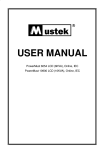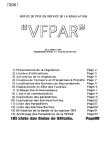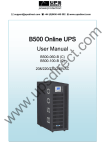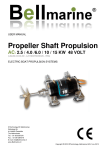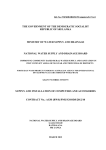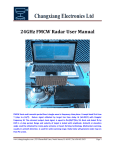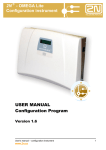Download User`s Manual - Cyber Power Systems
Transcript
User’s Manual CONTENT: 1. Safety and EMC Instructions .............................................................. 1 1.1 Installation........................................................................................ 1 1.2 Operation ........................................................................................ 2 1.3 Maintenance, Servicing and Faults ................................................. 2 1.4 Transport ......................................................................................... 3 1.5 Storage ............................................................................................ 1.6 Standards ........................................................................................ 2. Description of Commonly Used Symbols ......................................... 3. Introduction .......................................................................................... 3 4 5 6 3.1 Feature ............................................................................................ 6 3.2 Electrical Specifications................................................................... 7 3.3 Operating Environment ................................................................... 8 3.4 Typical Backup Time (Typical Values at 25°C In Minutes) .............. 9 3.5 Dimensions and Weights................................................................. 9 4. Installation .......................................................................................... 11 4.1 Moving to The Installation Site ...................................................... 11 4.2 Unpacking and Inspection ............................................................. 11 4.3 Input and Output Power W ires and Protective Earth Ground Installation............................................................................................ 12 4.4 Operating Procedure for Connecting With The External Battery .. 16 4.5 EPO Connection............................................................................ 17 5. Operation........................................................................... .................. 18 5.1 Display Panel................................................................................. 18 5.2 Turning On and Turning Off UPS .................................................. 21 5.3 LCD Operation............................................................................... 22 6. Special Function................................................................................. 28 6.1 ECO Function ................................................................................... 28 6.2 Converter Function ........................................................................ 29 6.3 Parallel Function............................................................................ 29 7. Trouble Shooting................................................................................ 35 7.1 Trouble Shooting According to Warning Indication ....................... 35 7.2 Trouble Shooting According To Fault Indication ............................ 37 7.3 Trouble Shooting In Else Cases .................................................... 38 8. Battery Maintenance .......................................................................... 39 9. Communication Port .......................................................................... 40 9.1 USB Interface ................................................................................ 40 9.2 Dry contact Interface(optional)....................................................... 40 9.3 RS-232 Interface ……….............................................................. 40 9.4 Intelligent slot................................................................................. 40 1. Safety and EMC Instructions Please read carefully the following user manual and the safety instructions before installing the unit or using the unit! 1.1 Installation This is permanently connected equipment, and it must be installed by qualified maintenance personnel. Condensation may occur if the UPS is moved directly from a cold to a warm environment. The UPS must be absolutely dry before being installed. Please allow an acclimatization time of at least two hours. Do not install the UPS near water or in damp environment. Do not install the UPS where it would be exposed to direct sunlight or near heat. Do not connect appliances or items of equipment which would overload the UPS (e.g. laser printers, etc.) to the UPS output. Place cables in such a way that no one can step on or trip over them. Connect UPS with the earth reliably before connecting to the building wiring terminal, and external battery source must also be earthed. An integral single emergency switching device which prevents further supply to the load by the UPS in any mode of operation should be provided in the building wiring installation. An appropriate disconnect device as short-circuit backup protection should be provided in the building wiring installation. The equipment is powered by two sources: the mains source, the internal battery or the external battery source. 1 With the installation of the equipment, the sum of the leakage current of the UPS and the connected load does not exceed 5% of rated value of input current. Do not block ventilation openings in the UPS’s housing. Ensure allow at least 50cm of space on front and rear of the UPS. 1.2 Operation Do not disconnect the mains cable on the UPS or the building wiring terminals during operation since this would remove the protective earth from the UPS and all connected loads. The UPS output terminal block may still be electrically lived even if the UPS is not connected to the building wiring terminal, for there is internal current source (batteries). In order to fully disconnect the UPS, first turn the input breaker in the “OFF” position, then disconnect the mains lead. Indiscriminate operation of switches may cause output loss or damage to equipment. Refer to instruction before conducting any control. While the UPSs work as a parallel system, the external parallel cable should be reinforced insulation. Ensure that no liquid or other foreign objects can enter the UPS. 1.3 Maintenance, Servicing and Faults Do not remove the enclosure since the UPS operates with hazardous voltages. It is to be serviced only by qualified maintenance personnel. Caution - risk of electric shock. Even after the unit is disconnected from the mains power supply (building wiring terminal), components inside the UPS are still connected to the battery which are potentially dangerous. 2 Before carrying out any kind of service and/or maintenance, isolate UPS and disconnect the batteries. Verify that no current is present and no hazardous voltage exists in the capacitor or BUS capacitor. Batteries must be replaced only by qualified personnel. Batteries have a high short-circuit current and pose a risk of shock. Take all precautionary measures specified below and any other necessary measures when working with batteries: remove all jewellery, wristwatches, rings and other metal objects use only tools with insulated grips and handles. When changing batteries, replace with the same quantity and the same type of batteries. Do not attempt to dispose of batteries by burning them. It could cause explosion. The UPS may be connected to external battery module (EBM). Proper disposal of batteries is required. Refer to your local codes for disposal requirements. Do not open or destroy batteries. Effluent electrolyte can cause injury to the skin and eyes. It may be toxic. Replace the fuse only by a fuse of the same type and of the same spec in order to avoid fire hazards. 1.4 Transport Please transport the UPS only in the original packaging to protect against shock and impact. 1.5 Storage The UPS must be stockpiled in the room where it is ventilated and dry. 3 1.6 Standards * Safety IEC/EN 62040-1 * EMI Conducted Emission..........................:IEC/EN 62040-2 Category C3 Radiated Emission.............................:IEC/EN 62040-2 Category C3 * EMS Level 3 Level 3 Level 4 Level 4 CS……………………………………...:IEC/EN 61000-4-6 Level 3 MS……………………………………..: IEC/EN 61000-4-8 Level 3 Voltage Dips……………………….....: IEC/EN 61000-4-11 Low Frequency Signals.....................:IEC/EN 61000-2-2 Warning: This is a product for commercial and industrial application in the needed to prevent disturbances. 4 2. Description of Commonly Used Symbols Some or all of the following symbols may be used in this manual. It is advisable to familiarize yourself with them and understand their meaning: Symbol Symbol and Explanation Explanation Symbol Explanation Alert you to pay special attention Caution of high voltage Alternating current source(AC) Direct current source(DC) Turn on or turn off the UPS Protective ground Recycle Do not dispose with ordinary trash 5 3. Introduction This On-Line series is an uninterruptible power supply incorporating double-converter technology. It provides perfect protection specifically for computer equipments, communication servers, and data centers. The double-converter principle eliminates all mains power disturbances. A rectifier converts the alternating current from the mains power to direct current. On the basis of this DC voltage, the inverter generates an AC sinusoidal voltage, which constantly supplies the loads. In the event of power failure, the maintenance-free batteries power the inverter. This manual covers the UPS listed as follows. Please confirm whether it is the model you intend to purchase by performing a visual inspection of the Model No. on the rear panel of the UPS. Model No. Type Model No. 6K 8K 6KXL 8KXL Standard 10K 10KXL Type Exended backup time “XL” Model: Extended backup time 3.1 Feature This series UPS is a new generation of UPS, which provides the outstanding reliability, and most cost-performance ratio in the industrial. Following benefit the product has: True online double-conversion technology with high power density, frequency independence, and generator compatibility. Output power factor is 0.9, perfect output sine waveform, suitable almost all critical equipment. High input power factor ≥0.99,overall high efficiency ≥ 0.92, save power and wiring expense for user. Low input current distortion, avoid power pollution. 6 Outstanding adaptability to the worst mains input condition. Extra wide input voltage, frequency range and waveform, avoid excessive dissipating limited battery energy. Internal charger could be up to 4Amps to decrease recharging time of battery. Optional external large charging current charger which is up to 12Amps could be supplied. N+X parallel redundancy to increase the reliability and flexibility. Number of parallel operating UPS is up to 4. ECO mode with high efficiency ≥ 0.96, save power expense for user. Start-able without battery. 3.2 Electrical specifications INPUT Model No. 6K(XL) 8K(XL) Phase Single Voltage 176~276VAC Frequency (45~55)/(54~66) Hz Current(A) 31(36) 10K(XL) 40(45.5) THDI 50(55) < 5% @ full load Power Factor 0.99 @ full load OUTPUT Model No. Power rating Voltage Frequency 6K(XL) 8K(XL) 6kVA/5.4kW 8kVA/7.2kW 10K(XL) 10kVA/9kW 208*/220/230/240×(1±1%) VAC 50/60× (1±0.05) Hz (Battery mode) 7 Wave form sine Load type PF 0.5~1, lagging < 2% @ full linear load <5% @ full nonlinear load In Line mode**: 10 min 105~125% 1 min 125~150% 10 S >150% 100 mS >170% In Battery mode: 2 min 105~125% 30 S 125~150% 100 mS >150% THDV Overload *The load capacity would be derated to 90% automatically when the output voltage is adjusted to 208VAC. **The overload capacity would be derated automatically in Line mode while the circumstance temperature is larger than 35 degree. BATTERIES Model No. Internal BAT number and type 6K 8K 20×12V 28W BAT pack 28A 10K 20×12V 28W 20×12V 34W 37.4A 47A 3.3 Operating Environment Operating Temperature 0 C to 45 C Operating humidity < 95% Altitude < 1000m* Storage temperature -15 C to 50 C *The load capacity should be derated 1% every 100m heightened on the basis of 1000m. 8 3.4 Typical Backup Time (Typical values at 25°C in minutes) Model No. 100 % Load 6K 5 8K 5 10K 4 3.5 Dimensions and Weights Model No. Dimensions W×H×D (mm) Net Weight (kg) 6K 260 x 708 x 550 70 6KXL 260 x 708 x 550 25 8K 260 x 708 x 550 86 8KXL 260 x 708 x 550 28 10K 260 x 708 x 550 86 10KXL 260 x 708 x 550 28 9 USB Port RS 232 EPO Port Dry contact (optional) Intelligent Slot Parallel Port Fan Maintenance Switch Input Breaker Terminal Block 6K(XL) 10K(XL) Fig. 3-1 Back View of 6K(XL)/10K(XL) *The back view of 8K(XL) models are same as 10K(XL) models. 10 4. Installation The system may be installed and wired only by qualified electricians in accordance with applicable safety regulations! When installing the electrical wiring, please note the nominal amperage of your incoming feeder. 4.1 Moving to The Installation Site The series UPS has wheels making it easy to move the UPS to the installation site after it has been unpacked. However, if the receiving area is far from the installation site, it is recommended to move the UPS by using a pallet jack or a truck before unpacking the UPS. 4.2 Unpacking and Inspection 1. At the installation site, the utmost care shall be taken when removing the packaging in order to avoid damaging the equipment. Cut the plastic poly-straps around the shipping container and remove the corrugated carton and the PS foam on the top of the UPS. With one or two people on each side of the UPS, lift the UPS out of the pallet. Warning: the plastic poly-straps around the shipping container are under tension. While cutting, don’t face to them, they will spring back and may cause eye injury. The shipping materials are recyclable. After unpacking, save them for later use or dispose of them appropriately. 11 2. Check all packaging materials to ensure that no items are missing. The shipping package contains: ● A UPS ● A user’s manual ● A USB cable ● A RS232 cable (optional) ● A parallel cable ● A parallel port cover plate ● Terminal splices 12pcs (using for the wire connection on input terminal) ● EPO connector ● PowerPanel® Business Edition software CD 3. Inspect the appearance of the UPS to see if there is any damage during transportation. Do not turn on the unit and notify the carrier and dealer immediately if there is any damage or lacking of some parts. 4.3 Input and Output Power Wires and Protective Earth Ground Installation 4.3.1 Notes for installation 1) The UPS must be installed in a location with good ventilation, far away from water, inflammable gas and corrosive agents. 2) Ensure the air vents on the front and rear of the UPS are not blocked. Allow at least 0.5m of space on each side. 3) Condensation to water drops may occur if the UPS is unpacked in a very low temperature environment. In this case it is necessary to wait until the UPS is fully dried inside out before proceeding installation and use. Otherwise there are hazards of electric shock. 12 4.3.2 Installation For safety, please cut off the mains power switch before installation! Use cable cross section and protective device specification Model Protective earthing conductor Min cross section 6k 8/10k 2 6mm (8AWG) Input L, N, G Min conductor cross section 2 6mm (8AWG) Input breaker 40A/250VAC Output L,N, Min conductor cross section 2 10 mm (6AWG) 2 10 mm (6AWG) 63A/250VAC 2 10 mm (6AWG) 6mm (8AWG) 2 10 mm (6AWG) External Battery Cabinet Fuse in Positive Pole(+), Negative pole(-), Neutral Pole 30A/240VDC 60A/240VDC External Battery Cabinet Breaker in Positive Pole(+), Negative pole(-), Neutral Pole 32A/240VDC 50A/240VDC 6mm (8AWG) External Battery Cabinet Positive Pole(+), Negative pole(-), Neutral Pole Min conductor cross section 2 3.95~4.97Nm (35~44 1b in) Torque for fixing above terminals 1) 2 It is suggested to install an external isolating device against current backfeed between Mains input and UPS (see Fig.4-6). After the device is installed, it must add a warning label with the following wording or the equivalent on the external AC contactor: RISK OF VOLTAGE BACKFEED. Isolate the UPS before operating on this circuit, then check for hazardous voltage between all terminals. 13 Fig.4-6 Typical external isolating device installation 2) No matter the UPS is connected to the mains power or not, the output of the UPS may be electrically live. The parts inside the unit may still have hazardous voltage after turning off the UPS. To make the UPS have no output, power off the UPS, and then cut off the mains power supply, wait the UPS shut down completely. 3) Open the terminal block cover located on the rear panel of UPS, please refer to the appearance diagram. 4) For 6KVA UPS, it is recommended to select the UL1015 2 8AWG/6mm or other insulated wire which complies with AWG Standard for the UPS input and output wirings. 5) For 8/10KVA UPS, it is recommended to select the UL1015 2 6AWG/10mm or other insulated wire which complies with AWG Standard for the UPS input and output wirings. 6) Ensure the capacity of mains power supply. Do not use the wall receptacle as the input power source for the UPS, as its rated current is less than the UPS’s maximum input current. Otherwise the receptacle may be burned and destroyed. 7) The protective earth ground wire should be installed first according to the following diagram. It is better to use green wire or green wire with yellow ribbon wire. 14 8) Connect other input and output wires to the corresponding input and output terminals according to the following diagram. 9) It is requested to use the accessorial terminal splices which can be compacted on the wires tightly, to ensure the connection between the wires and the terminal block is reliable. Fig. 4-7 Input and output Terminal Block wiring diagram Notes: 1) If the UPS is used in single mode, J1 and J2 must be connected. If the UPS is used in parallel mode, the Jumper between J1 and J2 must be removed. 2) Battery+/- connection is only for “XL” model. 10) Install an output breaker between the output terminal of UPS and the load, and the breaker should with leakage current protective function if necessary. 11) Turn off all the loads first before connecting the load with the UPS, then perform the connection and finally turn on the loads one by one. 12) After completing the installation, check all the wires is connected correctly and tightly. 13) Suggest charging the batteries for 8 hours before use. After installation, turn on the mains power switch and turn the input breaker in the “ON” position, the UPS will charge the batteries automatically. It can also use the UPS immediately without charging the batteries, but the backup time may be less than the standard value. 15 14) If it is necessary to connect the inductance load such as a monitor or a laser printer to the UPS, the start-up power should be used for calculating the capacity of the UPS, as its start-up power consumption is too big to make the UPS which capacity is small fail easily. 4.4 Operating Procedure For Connecting with The External Battery (Only for “XL” model) 1. The nominal DC voltage of external battery pack is 240VDC. Each battery pack consists of 20 pieces of 12V maintenance free batteries in series. To achieve longer backup time, it is possible to connect multi-battery packs, but the principle of “same voltage, same type” should be strictly followed. 2. 2 For 6KVA, select the UL1015 8AWG/6mm respectively or other insulated wire which complies with AWG Standard for the UPS battery wirings. 3. 2 For 8/10KVA, select the UL1015 6AWG/10mm respectively or other insulated wire which complies with AWG Standard for the UPS battery wirings. 4. The external battery pack must be independent for each UPS. It is forbidden that two UPSs use same external battery pack. 5. The procedure of installing battery pack should be complied with strictly. Otherwise it may encounter the hazardous of electric shock. 1) Ensure the UPS is not powered on and the mains input breaker is set in the “OFF” position. 2) A DC breaker must be installed between the external battery pack and the UPS. The capacity of breaker must be not less than the data specified in the general specification. 16 3) Set the external battery pack breaker in “OFF” position and connect the 20 pieces of batteries in series. 4) Connect the external battery pack to the battery terminals. Check the polarity of connection is correct. 5) Set the breaker of the battery pack in the “ON” position. 6) Set the mains input breaker in the “ON” position, the UPS would power on and start to charge the battery pack. 4.5 EPO Connection 4.5.1 Introduction Emergency power off function which the UPS supplies is, when the emergency occurs, such as the failure of load, the UPS can cut off the output at once by operating the EPO port manually. 4.5.2 The connection Normally the EPO connector is closed with a wire on the rear panel, which is supplied in the accessory. Once the connector is open, the UPS would stop the output and enter EPO status. Enable the EPO status Disable the EPO status Fig. 4-8 Default EPO status To recover to normal status, first EPO connector should be closed, and enter LCD menu (illustrated in the chapter of 5.3.3) to clear EPO status, then UPS would stop alarm and recover to Bypass model. And UPS needs be turned on by manual operation. 17 5. Operation 5.1 Display Panel The UPS has a five-button, dot matrix LCD with white text and a blue background. Besides the LCD, the UPS has four colorized LEDs to provide more convenient information. Fig. 5-1 Control Panel Table 5-1 Control Button Functions The Button Function Power on Illustration When the unit is no power and has connected power on. Turn on When the unit is powered on and is in Bypass mode, press this button more than 1S to turn on. Turn off When the unit has been turned on, press this button more than 3S to turn off. 18 Enter ESC Exit Press this button more than 200mS to confirm current selection or enter the current selection. Press this button more than 200mS to cancel current selection and return to previous menu. Up Press this button more than 200mS to move the focus to the up menu Down Press this button for more than 200mS to move the focus to the down menu. Table 5-2 LED definition UPS state Bypass mode with no output Bypass mode with output Normal LED (Green) Line mode 〇 Battery mode 〇 ECO mode 〇 Battery LED (Yellow) Fault LED (Red) ★ □ 〇 □ □ □ 〇 〇 □ ※ ※ ※ ※ ※ ※ ※ ※ □ 〇 □ ★ Fault mode Warning mode Bypass LED (Yellow) □ □ 19 Note 〇: Lightened constantly ※: #1-#4 Lightened circularly ★: Flashing □: Depended on the fault/warning status or other status Table 5-3 Alarm definition UPS condition Fault active Warning active Battery output Bypass output Overload Buzzer status Continuous Beep every second Beep every 4 seconds, if battery low, buzzer Beep every second Beep every 2 minutes Beep twice every second The UPS provides useful information about UPS itself, load status, battery, events, identification, and settings through the front panel display. During powering on, the LCD would display the CyberPower logo for several seconds and then enter to the default page which shows the UPS status summary. On the UPS status screen it provides the following information: Status summary, including mode, load, battery and utility Alarm status, if any is present. Fault status, if any is present. Output parameter, including output voltage, current and frequency. Input parameter, including input voltage and frequency. Bypass parameter, including bypass voltage and frequency. Power parameter, including output VA and watt. Battery parameter, including battery capacity, voltage and remain time. 20 5.2 Turning On and Turning Off UPS Attention: The UPS could only be turning on while connecting with the mains at the first time. Attention: Please switch off the connected loads first before turning on the UPS, and switch on the loads one by one after the UPS is turned on. Switch off all of the connected loads before turning off the UPS. 5.2.1 Turning on UPS with mains Check all the connection is correct. Check the breaker of 1) external battery pack is in “ON” position. 2) Set input breaker in “ON” position. At this time the fan begins to rotate, LCD will show “CyberPower”. Then LCD will show the default UPS status summary screen after UPS finishing self-test. 3) By pressing button continuously for more than 1 second, the buzzer will beep for 1s, UPS starts to turn on. 4) A few seconds later, the UPS turns into Line mode. If the mains power is abnormal, the UPS will transfer to Battery mode without output interruption of the UPS. 5.2.2 Turning on UPS without mains 1) Check all the connection is correct. Check the breaker of external battery pack is in “ON” position. 2) By pressing button continuously for more than 200mS, the UPS would be powered on. At this time the fan begins to rotate, LCD will show “CyberPower”. Then LCD will show the default UPS status summary screen after UPS finishing self-test. 3) By pressing button continuously for more than 1s, the buzzer will beep for 1s, UPS starts to turn on. 4) A few seconds later, the UPS turns into Battery mode. If the mains power comes back, the UPS will transfer to Line mode without output interruption of the UPS. 21 5.2.3 Turning off UPS with mains 1) To turn off the inverter of UPS by pressing button continuously for more than 3s and the buzzer will beep for 3s. The UPS will turn into Bypass mode at once. 2) When completing the above action, UPS output voltage is still present. In order to cut off the UPS output, simply cut off the mains power supply. A few seconds later, LCD display shuts down and no output voltage is available from the UPS output terminal. 5.2.4 Turning off UPS without mains 1) button continuously for To power off the UPS by pressin more than 3s, and the buzzer will beep 3s. The UPS will cut off the output at once. 2) A few seconds later, LCD shuts down and no voltage is available from the UPS output. 5.3 LCD Operation Except the default UPS status summary screen, the user could get more useful information about UPS current status, old events which ever occurred, UPS own identification, and could change the settings to fit the user own requirements, optimize the function of UPS. 5.3.1 The status screen In the UPS status screen, when pressing or >200 mS the detailed information about UPS information that include alarm, fault, output, input, bypass, load and battery parameter would be shown. when pressing > 200 mS the main menu would be shown. In fault or alarm screen, when press > 200mS, the other alarm or fault would be shown by press or >200mS, and press >200mS the display would return to status screen. The main menu includes four branches: UPS control menu, setting menu, event menu and identification menu. 22 Fig. 5-2 status menu 23 5.3.2 The UPS main menu Buzzer mute Yes No EPO Buzzer mute EPO Bat test Single UPS off Yes No Bat test yes Yes no No Single BatUPS test off yes Yes no No Event 0001:12:00:00 Utility abnormal 1/10 Alarm 0002:12:00:00 Overload 1/10 Events&alarms Fault Clear all events Clear all faults Fault 0003:12:00:00 Over tempearture 1/5 Clear all events Yes No Control Setting Events ID Clear all faults Yes No Type/model OLS 6000VA Standard model Serial number Type/model Serial number Rating Firmware version ************ Rating IP:230Vac/60Hz OP:230Vac/60Hz Power:6kVA/5.4kW Firmware version Ver:0.0.1 Please input password ... Fig. 5-3 main menu 24 Sub settings .... 5.3.3 The control menu By pressing on the menu of “Control”, the display would enter the next control menu screen. 1) Single UPS turn off: is one command to turn off one UPS which is operated currently in a parallel system, and other UPSs continue working to supply the load in the parallel system. 2) UPS battery test: is one command to control all UPS in a parallel system to do the battery test at the same time. 3) Clear EPO status: once EPO status is enabled, the UPS output would be cut off. To recover to normal status, first EPO connector should be closed, and enter this menu to clear EPO status, then UPS would stop alarm and recover to Bypass model. And UPS needs be turned on by manual operation. 4) Reset fault status: when fault occurs, UPS would keep in Fault mode and alarm. To recover to normal status, enter this menu to reset error status, then UPS would stop alarm and recover to Bypass mode. And the reason of fault should be checked and deleted before UPS is turned on again by manual operation. 25 5.3.4 The setting menu Please contact your local distributor for further information before using the settings. Some settings would change the specification, and some settings would enable or disable some functions. The unsuitable option set by user may result in potential failures or protecting function loss, even directly damage the load, battery or UPS. The most of settings could only be done while UPS is in Bypass mode. 26 Table 5-4 Submenu item Optional Values Default value User password enabled/disabled disabled Audio alarm enabled/disabled enabled Site wiring fault alarm enabled/disabled enabled Ambient warning enabled/disabled enabled DC start enabled/disabled enabled Auto Restart enabled/disabled enabled Automatic overload restart enabled/disabled enabled AutoBypass enabled/disabled enabled Short circuit clearance enabled/disabled disabled Power strategy** Rated output voltage Output frequency 208/220/230/240V autosensing/50/60Hz normal 230V autosensing Bypass voltage low range 10%,15%,20% 15% Bypass voltage high range 10%,15% 10% Bypass frequency range 10% 10% ECO voltage range 10%,15% 10% ECO frequency range Automatic battery tests period 1%~10% 5% 0-45days 7days Set running time Day:hour:minute:second 0000:0000:00~9999:23:59:59 Running time temperature Restore default setting *Password is AAAA when enabled. **Read the chapter of 6.1 and 6.2, before using ECO or converter function. 27 6. Special Function The series UPS has some special functions, which could satisfy some special application of user. And the functions have own features, please contact your local distributor for further information before using the function. 6.1 ECO Function 6.1.1 Brief introduction of ECO function If ECO function is set to enable, after the UPS is turned on, the power used by the load is directly supplied from the mains power via internal filter while the utility power is in normal range, so the economy mode could be gained in ECO mode. Once the mains power is loss or abnormal, the UPS would transfer to Line mode or Battery mode and the load is supplied continuously. The great virtue is overall high efficiency ≥ 0.96 of UPS, to save power for user. But the disadvantage is 1) the load can not be protected as well as in Line mode, for the load is directly supplied from the mains; 2) the transfer time of UPS output from ECO mode to Battery mode is about 10ms. So the function is not suitable to some sensitive loads, and the region where the mains power is unstable. 6.1.2 Set the function The function could be enabled through the LCD setting in Bypass mode. Enter the power strategy setting menu by following chapter of 5.3.4 28 6.2 Converter Function 6.2.1 Brief introduction of Converter function In converter mode, the UPS would free run with fixed output frequency (50Hz or 60Hz). Once the mains power is loss or abnormal, the UPS would transfer to Battery mode and the load is supplied continuously. The great virtue is the output frequency is fixed, which is required by some very sensitive loads. But the disadvantage is the load capacity of UPS should be derated to 60% in converter mode. 6.2.2 Set the function The function could be enabled through the LCD setting in Bypass mode. Enter the power strategy setting menu by following chapter of 5.3.4. 6.3 Parallel Function 6.3.1 Brief introduction of the redundancy N+X is currently the most reliable power supply structure. N represents the minimum UPS number that the total load needs, X represents the redundant UPS number, i.e. the fault UPS number that the system can handle simultaneously. When the X is larger, the reliability of the power system is higher. For occasions where reliability is highly depended on, N+X is the optimal mode. As long as the UPS is equipped with parallel cables, up to 4 UPSs can be connected in parallel to realize output power sharing and power redundancy. 29 6.3.2 Parallel installation and operation How to install a new parallel UPS system: 1) Before installing a new parallel UPS system, user need to prepare the input and output wires, the output breaker, and the parallel cable. 2) Users need to use a standard 25-pin communication cable, which should have 25 cores, corresponding stitches and shield, as the UPS parallel cable. The length of the parallel cable is appropriate to be less than 3m. And there is one standard parallel cable in the accessories of every UPS. 3) Remove the cover plate of the parallel port on the UPS, connect each UPS one by one with the parallel cable, and re-screw the Parallel port cover which is supplied in the accessories. 4) Strictly follow the chapter of 4, the wiring requirement of single UPS to perform the wiring of each UPS. 5) Connect the output wires of each UPS to an output breaker panel. 6) Disconnect the Jumper on J1 and J2 of the terminal block first, and connect each output breaker to a main output breaker and then to the loads. 7) Each UPS need an independent battery pack. 8) Please refer to the wiring diagram in the following diagram. 9) The distance between the UPSs in parallel and the breaker panel is required to be less than 20 meters. The difference between the wires of input and output of the UPSs is required to be less than 20%. 30 Fig. 6-1 Input and output Terminal Block wiring diagram 31 Fig. 6-2 Parallel System Installation Diagram 10) Do not switch on the output breaker of each UPS, switch on the input breaker of the each UPS, the UPS should work in bypass with output, observe their display to check if there are any warning or fault information, measure the output voltage of each UPS separately to check if the voltage difference between them is less than 1V. If the difference is more than 1V, check the wiring. 11) Press the button of one UPS, each UPS would start to turn on, all the UPSs would transfer to the INV mode together. Measure the output voltage of each UPS separately to check if the voltage difference between them is less than 0.5V. If the difference is more than 0.5V, the UPSs need to be regulated. 12) Press the button of one UPS, each UPS would start to turn off and transfer to the Bypass mode, switch on the output breaker of each UPS to parallel all the output of UPSs together. 32 13) Press the button of one UPS, each UPS would start to turn on, after turning on, the UPSs should work parallel in the Line mode. How to join a new UPS to a parallel system: 1) First the parallel system must be installed one main maintenance mechanical switch or static switch. 2) Regulate the output voltage of the new UPS separately: check if the output voltage difference between the new UPS and the parallel system is less than 0.5V. 3) Ensure the bypass of the parallel system is normal and the bypass setting is “enable”, remove the cover plate of maintenance switch on the rear panel of each UPS, the UPS system would transfer to bypass automatically, set the own maintenance switch of each UPS from “UPS” to “BPS”. 4) Set the main maintenance switch or static switch from “UPS” to “BPS”, switch off the main output breaker and the main input breaker, the UPSs would shut down. 5) Ensure the UPSs shut down totally, add the new UPS and reinstall the new UPS parallel system by following step 1) to 9) of last chapter - “install a new parallel UPS system”. 6) Switch on the main input breaker and the main output breaker, and set the main maintenance switch or static switch from “BPS” to “UPS”, then set the UPS own maintenance switch from “BPS” to “UPS” and screw the maintenance cover plate back again. Press the button of one UPS, each UPS would start to turn on, after turning on, the UPSs should work parallel in the Line mode. How to remove a single UPS from a parallel system: 1) First the parallel system must be installed one main maintenance mechanical switch or static switch. 33 2) Ensure the bypass is normal and the bypass setting is “enable”, remove the cover plate of maintenance switch on the rear panel of each UPS, the UPS system would transfer to bypass automatically, set the own maintenance switch of each UPS from “UPS” to “BPS”. 3) Set the main maintenance switch or static switch from “UPS” to “BPS”, switch off the main output breaker and the main input breaker, and the UPSs would shut down. 4) Ensure the UPSs shut down totally, remove the wanted UPS and reinstall the new UPS parallel system by following step 1) to 9) of last chapter - “install a new parallel UPS system”. 5) If the removed UPS or the remained UPS will be used in a stand-alone mode, then J1 and J2 on the terminal block should be connected with a short connection wire. 6) Switch on the main input breaker and the main output breaker, and set the main maintenance switch or static switch from “BPS” to “UPS”, then set the UPS own maintenance switch from “BPS” to “UPS” and screw the maintenance cover plate back again. Press the button of one UPS, each UPS would start to turn on, after turning on, the UPSs should work parallel in the Line mode. 34 7. Trouble Shooting If the UPS system does not operate correctly, first check the operating information on the LCD display. Please attempt to solve the problem using the table below. If the problem still persists, consult your dealer. 7.1 Trouble Shooting According To Warning Indication Problem Displayed Read EEPROM Error Possible cause Remedy UPS internal fault EPO connector is open Maintain bypass switch is open Consult dealer. Check the EPO connector status Check the maintain bypass switch status IP softstart failed UPS internal fault Consult dealer Site Wiring Fault Phase and neutral conductor at input of UPS system are reversed Reverse mains power wiring. Battery Disconnect Battery pack is not connected correctly Do the battery test to confirm. Check the battery bank is connected to the UPS. Check the battery breaker is turn on. Battery low Battery voltage is low When audible alarm sounding Output Overload Overload Fan Failure Fan abnormal Charger Fail The charge fails Battery Over Voltage Battery voltage is higher than normal value EPO Active On Maintain Bypass 35 empty. Check the loads and remove some non-critical loads. Check if some loads are failed. Check if the fan is running normally. Consult dealer. Check if the battery quantity is right. Over Charge Battery is over charged The UPS will turn off the is normal Model Pin Error Ambient Over Temperature UPS internal fault The ambient temperature is too high Consult dealer. Check the environment ventilation. Heatsink Over Temperature Inside temperature of UPS is too high Check the ventilation of UPS and the ambient temperature. Ambient NTC abnormal Para Cable Male Loss UPS internal fault The parallel cable is disconnected Consult dealer. Check the parallel cable. Para Cable Female Loss The parallel cable is disconnected Check the parallel cable. Para Bat Differ The battery packs of some UPSs are disconnected Check if all the battery pack is connected. Para Line Differ The mains input of some UPSs is disconnected Check the building wiring and input cable. Check if the input breaker is closed. Ensure the UPSs are connected to same input source. Para Work Mode Differ There are different power strategy setting in parallel system The UPSs with different power strategy setting (Ex. one Line Para Rate Power Differ There are different UPSs in parallel system The UPSs with different capacity (Ex. one 6KVA and one 10KVA) are forbidden to parallel. ECO In Para ECO function is enabled in parallel system Input fuse break ECO function is forbidden in parallel system. are forbidden to parallel. IP Fuse Open 36 Check the input fuse status 7.2 Trouble Shooting According To Fault Indication Problem Displayed Inv Overload Fault Possible cause Overload Remedy Check the loads and remove some non-critical loads. Check if some loads are failed. Byp Overload Fault Overload Check the loads and remove some non-critical loads. Check if some loads are failed. Output Short Circuit Output short circuit Remove all the loads. Turn off the UPS. Check if UPS output and loads is short circuit. Ensure short circuit is removed before turning on again. Heatsink Over Temperature Fault Inside temperature of UPS is too high Check the ventilation of UPS and the ambient temperature. Bus Over Voltage UPS internal fault Consult dealer. Bus Under Voltage UPS internal fault Consult dealer. Bus Unbalance UPS internal fault Consult dealer. Bus short UPS internal fault Consult dealer. Bus Softstart Fail UPS internal fault Consult dealer. Inv Over Voltage UPS internal fault Consult dealer. Inv Under Voltage UPS internal fault Consult dealer. Inv Softstart Fail UPS internal fault Consult dealer. Negative Power Fault The load is pure inductive and capacitive Remove some non-critical loads. Bypass supplies the load first, ensure there is no overload, then turn on UPS. Cable male and female Loss fault Fan lock fault Back Feed The parallel cable is disconnected Fan blocked or disconnected over time Output voltage is returned to input 37 Check the parallel cable. Check the fan status Consult dealer 7.3 Trouble Shooting In Else Cases Problem Possible cause Remedy No indication, no warning tone even though system is connected to mains power supply No input voltage BYPASS LED light up even though the power supply is available Inverter not switched on Press On-Switch “I” to turn on UPS. BATTERY LED lights up, and audible alarm sounding every 1 beep in every 4 seconds Input voltage and/or frequency are out of tolerance Check input power source. Emergency supply period shorter than nominal value Batteries not fully charged / batteries defect Check the building wiring and input cable. Check if the input breaker is closed. Check the building wiring and input cable. Check if the input breaker is closed. 12 hours and then check capacity. Please have the following information at hand before calling the After-Sales Service Department: 1. Model number, serial number 2. Date on which the problem occurred 3. LCD/LED display information, Buzzer alarm status 4. Mains power condition, load type and capacity, environment temperature, ventilation condition 5. The information (battery capacity, quantity) of external battery pack if the UPS is “XL” model 6. Other information for complete description of the problem 38 8. Battery Maintenance Battery replacement should be performed by qualified personnel. This series UPS only requires minimal maintenance. The battery used for standard models are value regulated sealed lead-acid maintenance free battery. These models require minimal repairs. The only requirement is to charge the UPS regularly in order to maximize the expected life of the battery. When being connected to the mains power, whether the UPS is turned on or not, the UPS keeps charging the batteries and also offers the protective function of overcharging and over-discharging. The UPS should be charged once every 4 to 6 months if it has not been used for a long time. In the regions of hot climates, the battery should be charged and discharged every 2 months. The standard charging time should be at least 12 hours. Under normal conditions, the battery life lasts 3 to 5 years. In case if the battery is found not in good condition, earlier replacement should be made. Replace batteries with the same number and same type of batteries. Do not replace the battery individually. All the batteries should be replaced at the same time following the instructions of the battery supplier. If the battery service life (3~5 years at 25°C ambient temperature) has been exceeded, the batteries must be replaced. 39 9. Communication Port 9.1 USB Interface The USB port is compliance with USB 1.1 protocol for its communication software. 9.2 Dry contact Interface(optional) This series UPS has independent dry contact interface. Please contact your local distributor for details. 9.3 RS-232 Interface The RS-232 port is available for UPS monitoring, control, and firmware updates. 9.4 Intelligent slot This series is equipped with an intelligent slot for other optional card to achieve remote management of the UPS through internet / intranet. Please contact your local distributor for further information. 40











































